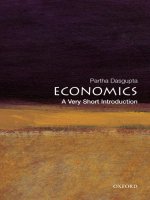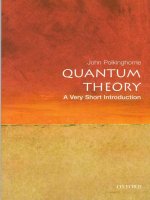Game theory: A very short introduction
Bạn đang xem bản rút gọn của tài liệu. Xem và tải ngay bản đầy đủ của tài liệu tại đây (2.99 MB, 201 trang )
Game Theory: A Very Short Introduction
VERY SHORT INTRODUCTIONS are for anyone wanting a stimulating
and accessible way in to a new subject. They are written by experts, and have
been published in more than 25 languages worldwide.
The series began in 1995, and now represents a wide variety of topics in
history, philosophy, religion, science, and the humanities. Over the next
few years it will grow to a library of around 200 volumes – a Very Short
Introduction to everything from ancient Egypt and Indian philosophy to
conceptual art and cosmology.
Very Short Introductions available now:
AFRICAN HISTORY
John Parker and Richard Rathbone
AMERICAN POLITICAL
PARTIES AND
ELECTIONS
L. Sandy Maisel
THE AMERICAN
PRESIDENCY
Charles O. Jones
ANARCHISM Colin Ward
ANCIENT EGYPT Ian Shaw
ANCIENT PHILOSOPHY
Julia Annas
ANCIENT WARFARE
Harry Sidebottom
ANGLICANISM Mark Chapman
THE ANGLO-SAXON AGE
John Blair
ANIMAL RIGHTS DavidDeGrazia
Antisemitism Steven Beller
ARCHAEOLOGY Paul Bahn
ARCHITECTURE
Andrew Ballantyne
ARISTOTLE Jonathan Barnes
ART HISTORY Dana Arnold
ART THEORY Cynthia Freeland
THE HISTORY OF
ASTRONOMY
MichaelHoskin
ATHEISM Julian Baggini
AUGUSTINE Henry Chadwick
BARTHES Jonathan Culler
BESTSELLERS John Sutherland
THE BIBLE John Riches
THE BRAIN Michael O’Shea
BRITISH POLITICS
Anthony Wright
BUDDHA Michael Carrithers
BUDDHISM Damien Keown
BUDDHIST ETHICS
Damien Keown
CAPITALISM James Fulcher
THE CELTS Barry Cunliffe
CHAOS Leonard Smith
CHOICE THEORY
Michael Allingham
CHRISTIAN ART
Beth Williamson
CHRISTIANITY Linda Woodhead
CLASSICS Mary Beard and
John Henderson
CLASSICAL MYTHOLOGY
Helen Morales
CLAUSEWITZ Michael Howard
THE COLD WAR
Robert McMahon
CONSCIOUSNESS
Susan Blackmore
CONTEMPORARY ART
Julian Stallabrass
CONTINENTAL PHILOSOPHY
Simon Critchley
COSMOLOGY Peter Coles
THE CRUSADES
Christopher Tyerman
CRYPTOGRAPHY
Fred Piper and Sean Murphy
DADA AND SURREALISM
David Hopkins
DARWIN Jonathan Howard
THE DEAD SEA SCROLLS
Timothy Lim
DEMOCRACY Bernard Crick
DESCARTES Tom Sorell
DESIGN John Heskett
DINOSAURS David Norman
DOCUMENTARY FILM
Patricia Aufderheide
DREAMING J. Allan Hobson
DRUGS Leslie Iversen
THE EARTH Martin Redfern
ECONOMICS Partha Dasgupta
EGYPTIAN MYTH
Geraldine Pinch
EIGHTEENTH-CENTURY
BRITAIN
Paul Langford
THE ELEMENTS Philip Ball
EMOTION Dylan Evans
EMPIRE Stephen Howe
ENGELS Terrell Carver
ETHICS Simon Blackburn
THE EUROPEAN UNION
John Pinder
EVOLUTION
Brian and Deborah Charlesworth
EXISTENTIALISM Thomas Flynn
FASCISM Kevin Passmore
FEMINISM Margaret Walters
THE FIRST WORLD WAR
Michael Howard
FOSSILS Keith Thomson
FOUCAULT Gary Gutting
THE FRENCH REVOLUTION
William Doyle
FREE WILL Thomas Pink
FREUD Anthony Storr
FUNDAMENTALISM
Malise Ruthven
GALILEO Stillman Drake
Game theory Ken Binmore
GANDHI Bhikhu Parekh
GEOPOLITICS Klaus Dodds
GLOBAL CATASTROPHES
Bill McGuire
GLOBALIZATION
Manfred Steger
GLOBAL WARMING
Mark Maslin
THE GREAT DEPRESSION
AND THE NEW DEAL
Eric Rauchway
HABERMAS
James Gordon Finlayson
HEGEL Peter Singer
HEIDEGGER Michael Inwood
HIEROGLYPHS Penelope Wilson
HINDUISM Kim Knott
HISTORY John H. Arnold
HOBBES Richard Tuck
HUMAN EVOLUTION
Bernard Wood
HUMAN RIGHTS
Andrew Clapham
HUME A. J. Ayer
IDEOLOGY Michael Freeden
INDIAN PHILOSOPHY
Sue Hamilton
INTELLIGENCE Ian J. Deary
INTERNATIONAL
MIGRATION
Khalid Koser
INTERNATIONAL
RELATIONS
Paul Wilkinson
ISLAM Malise Ruthven
JOURNALISM Ian Hargreaves
JUDAISM Norman Solomon
JUNG Anthony Stevens
KABBALAH Joseph Dan
KAFKA Ritchie Robertson
KANT Roger Scruton
KIERKEGAARD Patrick Gardiner
THE KORAN Michael Cook
LINGUISTICS Peter Matthews
LITERARY THEORY
Jonathan Culler
LOCKE John Dunn
LOGIC Graham Priest
MACHIAVELLI Quentin Skinner
THE MARQUIS DE SADE
John Phillips
MARX Peter Singer
MATHEMATICS
Timothy Gowers
MEDICAL ETHICS Tony Hope
MEDIEVAL BRITAIN
John Gillingham and
Ralph A. Griffiths
MODERN ART David Cottington
MODERN IRELAND
Senia Pašeta
MOLECULES Philip Ball
MUSIC Nicholas Cook
MYTH Robert A. Segal
NATIONALISM Steven Grosby
THE NEW TESTAMENT AS
LITERATURE
Kyle Keefer
NEWTON Robert Iliffe
NIETZSCHE Michael Tanner
NINETEENTH-CENTURY
BRITAIN
Christopher Harvie
and H. C. G. Matthew
NORTHERN IRELAND
Marc Mulholland
PARTICLE PHYSICS Frank Close
PAUL E. P. Sanders
PHILOSOPHY Edward Craig
PHILOSOPHY OF LAW
Raymond Wacks
PHILOSOPHY OF SCIENCE
Samir Okasha
PHOTOGRAPHY Steve Edwards
PLATO Julia Annas
POLITICS Kenneth Minogue
POLITICAL
PHILOSOPHY
David Miller
POSTCOLONIALISM
Robert Young
POSTMODERNISM
Christopher Butler
POSTSTRUCTURALISM
Catherine Belsey
PREHISTORY Chris Gosden
PRESOCRATIC PHILOSOPHY
Catherine Osborne
PSYCHOLOGY
Gillian Butler and Freda McManus
PSYCHIATRY Tom Burns
QUANTUM THEORY
John Polkinghorne
RACISM Ali Rattansi
THE RENAISSANCE
Jerry Brotton
RENAISSANCE ART
Geraldine A. Johnson
ROMAN BRITAIN Peter Salway
THE ROMAN EMPIRE
Christopher Kelly
ROUSSEAU Robert Wokler
RUSSELL A. C. Grayling
RUSSIAN LITERATURE
Catriona Kelly
THE RUSSIAN REVOLUTION
S. A. Smith
SCHIZOPHRENIA
Chris Frith and Eve Johnstone
SCHOPENHAUER
Christopher Janaway
SHAKESPEARE Germaine Greer
SIKHISM Eleanor Nesbitt
SOCIAL AND CULTURAL
ANTHROPOLOGY
John Monaghan and Peter Just
SOCIALISM Michael Newman
SOCIOLOGY Steve Bruce
SOCRATES C. C. W. Taylor
THE SPANISH CIVIL WAR
Helen Graham
SPINOZA Roger Scruton
STUART BRITAIN John Morrill
TERRORISM Charles Townshend
THEOLOGY David F. Ford
THE HISTORY OF TIME
Leofranc Holford
–
Strevens
TRAGEDY Adrian Poole
THE TUDORS John Guy
TWENTIETH-CENTURY
BRITAIN
Kenneth O. Morgan
THE VIKINGS Julian Richards
WITTGENSTEIN A. C. Grayling
WORLD MUSIC
Philip Bohlman
THE WORLD TRADE
ORGANIZATION
Amrita Narlikar
Available soon:
Expressionism
Katerina Reed
–
Tsocha
Galaxies John Gribbin
Geography John Matthews and
David Herbert
German Literature
Nicholas Boyle
HIV/AIDS Alan Whiteside
The Meaning of Life
Terry Eagleton
Memory Jonathan Foster
Modern China
Rana Mitter
Nuclear Weapons
Joseph M. Siracusa
Quakerism Pink Dandelion
Science and
Religion
Thomas Dixon
Sexuality
Véronique Mottier
For more information visit our web site
www.oup.co.uk/general/vsi/
Ken Binmore
Game Theory
A Very Short Introduction
1
1
Great Clarendon Street, Oxford ox26dp
Oxford University Press is a department of the University of Oxford.
It furthers the University’s objective of excellence in research, scholarship,
and education by publishing worldwide in
Oxford New York
Auckland Cape Town Dar es Salaam Hong Kong Karachi
Kuala Lumpur Madrid Melbourne Mexico City Nairobi
New Delhi Shanghai Taipei Toronto
With offices in
Argentina Austria Brazil Chile Czech Republic France Greece
Guatemala Hungary Italy Japan Poland Portugal Singapore
South Korea Switzerland Thailand Turkey Ukraine Vietnam
Oxford is a registered trade mark of Oxford University Press
in the UK and in certain other countries
Published in the United States
by Oxford University Press Inc., New York
c
Ken Binmore 2007
The moral rights of the author have been asserted
Database right Oxford University Press (maker)
First Published as a Very Short Introduction 2007
All rights reserved. No part of this publication may be reproduced,
stored in a re t rieval system, or transmitted, in any form or by any means,
without the prior permission in writing of Oxford University Press,
or as expressly permitted by law, or under terms agreed with the appropriate
reprographics rights organization. Enquiries concerning reproduction
outside the scope of the above should be sent to the Rights Department,
Oxford University Press, at the address above
You must not circulate this book in any other binding or cover
and you must impose the same condition on any acquirer
British Library Cataloguing in Publication Data
Data available
Library of Congress Cataloging in Publication Data
Data available
ISBN 978–0–19–921846–2
10987654321
Typeset by SPI Publisher Services, Pondicherry, India
Printed in Great Britain
on acid-free paper by
Ashford Colour Press Ltd, Gosport, Hampshire
To
Peter and Nina
This page intentionally left blank
Contents
List of illustrations xiii
1
Thenameofthegame 1
2
Chance 22
3
Time 36
4
Conventions 57
5
Reciprocity 71
6
Information 88
7
Auctions 102
8
Evolutionary biology 117
9
Bargaining and coalitions 140
10
Puzzles and paradoxes 158
References and further reading 175
Index 181
This page intentionally left blank
List of illustrations
1 Matching Pennies 4
2 Payoff tables 5
3 Numerical payoffs 10
4 Games with mixed
motivations
11
5 James Dean 12
c
2004 TopFoto
6 John Nash 13
c
Robert P. Matthews/Princeton
University/Getty Images
7 Two versions of the Prisoner’s
Dilemma
18
8 Rolling dice 24
c
iStockphoto
9 Learning to play an
equilibrium
28
10 Two board games 39
11 Kidnap 44
12 Cosy Kidnap 46
13 Ultimatum Minigame 49
14 Evolutionary adjustment
in the Ultimatum
Minigame
50
15 Simplified Chain Store
paradox
53
16 David Hume 61
c
Hulton Archive/Getty Images
17 Schelling’s Solitaire 63
18 Stag Hunt Game 69
19 Reciprocal grooming by
chimps
74
c
Peter Arnold Inc./Alamy
20 The folk theorem 77
21 Information sets for Matching
Pennies
89
22 Full house 90
c
iStockphoto
23 Maximin play in Von
Neumann’s Poker
model
91
24 Von Neumann’s model 93
25 Payoff table for Von
Neumann’s Poker
model
94
26 Incomplete information in
Chicken
96
27 The Judgement of
Solomon
105
28 Going, Going, Gone! 108
c
Hiu Yin Leung/Fotolia
29 Replicator dynamics in the
Hawk-Dove Game
126
30 Relatives play the Prisoner’s
Dilemma
131
31 Vampire bat 135
c
Michael and Patricia
Fogden/Corbis
32 Hawk-Dove-Retaliator
Game
137
33 The Nash bargaining
solution
144
34 Transparent disposition
fallacy
163
35 Two attempts to
satisfy Newcomb’s
requirements
165
36 Three midwestern
ladies
168
Library of Congress, Prints and
Photographs Division, FSA-OW1
Collection (reproduction no.
LC-USF33-012381-M5 DLC)
37 Monty Hall Game 173
The publisher and the author apologize for any errors or omissions in the
above list. If contacted they will be pleased to rectify these at the earliest
opportunity.
Chapter 1
The name of the game
What is game theory about?
When my wife was away for the day at a pleasant little conference
in Tuscany, three young women invited me to share their table for
lunch. As I sat down, one of them said in a sultry voice, ‘Teach us
how to play the game of love’, but it turned out that all they wanted
was advice on how to manage Italian boyfriends. I still think they
were wrong to reject my strategic recommendations, but they were
right on the nail in taking for granted that courting is one of the
many different kinds of game we play in real life.
Drivers manoeuvring in heavy traffic are playing a driving game.
Bargain-hunters bidding on eBay are playing an auctioning game.
A firm and a union negotiating next year’s wage are playing a
bargaining game. When opposing candidates choose their
platform in an election, they are playing a political game. The
owner of a grocery store deciding today’s price for corn flakes is
playing an economic game. In brief, a game is being played
whenever human beings interact.
Antony and Cleopatra played the courting game on a grand scale.
Bill Gates made himself immensely rich by playing the computer
software game. Adolf Hitler and Josef Stalin played a game that
killed off a substantial fraction of the world’s population. Kruschev
1
Game Theory
and Kennedy played a game during the Cuban missile crisis that
might have wiped us out altogether.
With such a wide field of application, game theory would be a
universal panacea if it could always predict how people will play
the many games of which social life largely consists. But game
theory isn’t able to solve all of the world’s problems, because it
only works when people play games rationally.Soitcan’tpredict
the behaviour of love-sick teenagers like Romeo or Juliet, or
madmen like Hitler or Stalin. However, people don’t always
behave irrationally, and so it isn’t a waste of time to study what
happens when people put on their thinking caps. Most of us at
least try to spend our money sensibly – and we don’t do too badly
much of the time or economic theory wouldn’t work at all.
Even when people haven’t thought everything out in advance, it
doesn’t follow that they are necessarily behaving irrationally.
Game theory has had some notable successes in explaining the
behaviour of spiders and fish, neither of which can be said to think
at all. Such mindless animals end up behaving as though they were
rational, because rivals whose genes programmed them to behave
irrationally are now extinct. Similarly, companies aren’t always
run by great intellects, but the market is often just as ruthless as
Nature in eliminating the unfit from the scene.
Does game theory work?
In spite of its theoretical successes, practical men of business used
to dismiss game theory as just one more ineffectual branch of
social science, but they changed their minds more or less overnight
after the American government decided to auction off the right to
use various radio frequencies for use with cellular telephones.
With no established experts to get in the way, the advice of game
theorists proved decisive in determining the design of the rules of
the auctioning games that were used. The result was that the
2
The name of the game
American taxpayer made a profit of $20 billion – more than twice
the orthodox prediction. Even more was made in a later British
telecom auction for which I was responsible. We made a total of
$35 billion in just one auction. In consequence, Newsweek
magazine described me as the ruthless, Poker-playing economist
who destroyed the telecom industry!
As it turned out, the telecom industry wasn’t destroyed. Nor is it at
all ruthless to make the fat cats of the telecom industry pay for
their licences what they think they are worth – especially when the
money is spent on hospitals for those who can’t afford private
medical care. As for Poker, it is at least 20 years since I played for
more than nickels and dimes. The only thing that Newsweek got
right is that game theory really does work when applied by people
who know what they are doing. It works not just in economics, but
also in evolutionary biology and political science. In my recent
book Natural Justice, I even outrage orthodox moral philosophers
by using game theory when talking about ethics.
Toy games
Each new big-money telecom auction needs to be tailored to the
circumstances in which it is going to be run. One can’t just take a
design off the shelf, as the American government found when it
hired Sotheby’s to auction off a bunch of satellite transponders.
But nor can one capture all the complicated ins and outs of a new
telecom market in a mathematical model. Designing a telecom
auction is therefore as much an art as a science. One extrapolates
from simple models chosen to mimic what seem to be the essential
strategic features of a problem.
I try to do the same in this book, which therefore contains no
algebra and a minimum of technical jargon. It looks only at toy
games, leaving aside all the bells and whistles with which they are
complicated in real life. However, most people find that even toy
games give them plenty to think about.
3
Game Theory
1. Alice and Bob’s decision problem in Matching Pennies
Conflict and cooperation
Most of the games in this book have only two players, called Alice
and Bob. The first game they will play is Matching Pennies.
Sherlock Holmes and the evil Professor Moriarty played Matching
Pennies on the way to their final confrontation at the Reichenbach
Falls. Holmes had to decide at which station to get off a train.
Moriarty had to decide at which station to lie in wait. A real-life
counterpart is played by dishonest accountants and their auditors.
The former decide when to cheat and the latter decide when to
inspect the books.
In our toy version, Alice and Bob each show a coin. Alice wins if
both coins show the same face. Bob wins if they show different
faces. Alice and Bob therefore each have two strategies, heads and
tails. Figure 1 shows who wins and loses for all possible strategy
combinations. These outcomes are the players’ payoffs in the
game. The thumbs-up and thumbs-down icons have been used to
emphasize that payoffs needn’t be measured in money.
Figure 2 shows how all the information in Figure 1 can be
assembled into a payoff table, with Alice’s payoff in the southwest
corner of each cell, and Bob’s in the northeast corner. It also shows
a two-player version of the very different Driving Game that we
4
The name of the game
2. Payoff tables. Alice chooses a row and Bob chooses a column
play every morning when we get into our cars to drive to work.
Alice and Bob again have two pure strategies, left and right, but
now the players’ payoffs are totally aligned instead of being
diametrically opposed. When journalists talk about a win-win
situation, they have something like the Driving Game in mind.
Von Neumann
The first result in game theory was John Von Neumann’s minimax
theorem, which applies only to games like Matching Pennies in
which the players are modelled as implacable enemies. One
sometimes still reads dismissive commentaries on game theory in
which Von Neumann is caricatured as the archetypal cold
warrior – the original for Dr Strangelove in the well known movie.
We are then told that only a crazed military strategist would think
of applying game theory in real life, because only a madman or a
cyborg would make the mistake of supposing that the world is a
game of pure conflict.
Von Neumann was an all-round genius. Inventing game theory
was just a sideline for him. It is true that he was a hawk in the
Cold War, but far from being a mad cyborg, he was a genial soul,
who liked to party and have a good time. Just like you and me, he
preferred cooperation to conflict, but he also understood that the
5
Game Theory
way to achieve cooperation isn’t to pretend that people can’t
sometimes profit by causing trouble.
Cooperation and conflict are two sides of the same coin, neither of
which can be understood properly without taking account of the
other. To consider a game of pure conflict like Matching Pennies
isn’t to claim that all human interaction is competitive. Nor is one
claiming that all human interac tion is cooperative when one looks
at a game of pure coordination like the Driving Game. One is
simply distinguishing two different aspects of human behaviour so
that they can be studied one at a time.
Revealed preference
To cope with cooperation and conflict together, we need a better
way of describing the motivation of the players than simply saying
that they like winning and dislike losing. For this purpose,
economists have invented the idea of utility, which allows each
player to assign a numerical value to each possible outcome of a
game.
In business, the bottom line is commonly profit, but economists
know that human beings often have more complex aims than
simply making as much money as they can. So we can’t identify
utility with money. A naive response is to substitute happiness for
money. But what is happiness? How do we measure it?
It is unfortunate that the word ‘utility’ is linked historically with
Victorian utilitarians like Jeremy Bentham and John Stuart Mill,
because modern economists don’t follow them in identifying
utility with how much pleasure or how little pain a person may
feel. The modern theory abandons any attempt to explain how
people behave in terms of what is going on inside their heads. On
the contrary, it makes a virtue of making no psychological
assumptions at all.
6
The name of the game
We don’t try to explain why Alice or Bob behave as they do.
Instead of an explanatory theory, we have to be content with a
descriptive theory, which can do no more than say that Alice or
Bob will be acting inconsistently if they did such-and-such in the
past, but now plan to do so-and-so in the future. In game theory,
the object is to observe the decisions that Alice and Bob make (or
would make) when they aren’t interacting with each other or
anyone else, and to deduce how they will behave when interacting
in a game.
We therefore don’t argue that some preferences are more rational
than others. We follow the great philosopher David Hume in
regarding reason as the ‘slave of the passions’. As he e xtravagantly
remarked, there would be nothing irrational about his preferring
the destruction of the entire universe to scratching his finger.
However, we go even further down this road by regarding reason
purely as an instrument for avoiding inconsistent behaviour. Any
consistent behaviour therefore counts as rational.
With some mild assumptions, acting consistently can be shown to
be the same as behaving as though seeking to maximize the value
of something. Whatever this abstract something may be in a
particular context, economists call it utility. It needn’t correlate
with money, but it sadly often does.
Taking risks
In acting consistently, Alice may not be aware that she is behaving
as though maximizing something we choose to call her utility. But
if we want to predict her behaviour, we need to be able to measure
her utility on a utility scale, much as temperature is measured on a
thermometer. Just as the units on a thermometer are called
degrees, we can then say that a util is a unit on Alice’s utility scale.
The orthodoxy in economics used to be that such cardinal utility
scales are intrinsically nonsensical, but Von Neumann fortunately
7
Game Theory
didn’t know this when Oskar Morgenstern turned up at his house
one day complaining that they didn’t have a proper basis for the
numerical payoffs in the book on game theory they were writing
together. So Von Neumann invented a theory on the spot that
measures how much Alice wants something by the size of the risk
she is willing to take to get it. We can then figure out what choice
she will make in risky situations by finding the option that will
give her the highest utility on average.
It is easy to use Von Neumann’s theory to find how much utility to
assign to anything Alice may need to evaluate. For example, how
many utils should Alice assign to getting a date with Bob?
We first need to decide what utility scale to use. For this purpose,
pick two outcomes that are respectively better and worse than any
other outcome Alice is likely to encounter. These outcomes will
correspond to the boiling and freezing points of water used to
calibrate a Celsius thermometer, in that the utility scale to be
constructed will assign 0 utils to the worst outcome, and 100 utils
to the best outcome. Next consider a bunch of (free) lottery tickets
in which the only prizes are either the best outcome or the worst
outcome.
When we offer Alice lottery tickets with higher and higher
probabilities of getting the best outcome as an alternative to a date
with Bob, she will eventually switch from saying no to saying yes.
If the probability of the best outcome on the lottery ticke t that
makes her switch is 75%, then Von Neumann’s theory says that a
date with Bob is worth 75 utils to her. Each extra percentage point
added to her indifference probability therefore corresponds to one
extra util.
When some people evaluate sums of money using this method,
they always assign the same number of utils to each extra dollar. We
call such people risk neutral. Those who assign fewer utils to each
extra dollar than the one that went before are called risk averse.
8
The name of the game
Insurance
Alice is thinking of accepting an offer from Bob to insure her
Beverley Hills mansion against fire. If she refuses his offer, she
faces a lottery in which she ends up with her house plus the
insurance premium if her house doesn’t burn down, and with only
the premium if it does. This has to be compared with her ending
up for sure with the value of the house less the premium if she
accepts Bob’s offer.
If it is rational for Bob to make the offer and for Alice to accept, he
must think that the lottery is better than breaking even for sure,
and she must have the opposing preference. The existence of the
insurance industry therefore confirms not only that it can be
rational to gamble – provided that the risks you take are calculated
risks – but that rational people can have different attitudes to
taking risks. In the insurance industry, the insurers are close to
being risk neutral and the insurees are risk averse to varying
degrees.
Notice that economists regard the degree of risk aversion that a
person reveals as a matter of personal preference. Just as Alice
may or may not prefer chocolate ice-cream to vanilla, so she may
or may not prefer to spend $1,000 on insuring her house. Some
philosophers – notably John Rawls – insist that it is rational to be
risk averse when defending whatever alternative to maximizing
average utility they prefer, but such appeals miss the point that the
players’ attitudes to taking risks have already been taken into
account when using Von Neumann’s method to assign utilities to
each outcome.
Economists make a different mistake when they attribute risk
aversion to a dislike of the act of gambling. Von Neumann’s theory
only makes sense when the players are entirely neutral to the
actual act of gambling. Like a Presbyterian minister insuring his
house, the y don’t gamble because they enjoy gambling – they
gamble only when they judge that the odds are in their favour.
9
Game Theory
3. Numerical payoffs
Life isn’t a zero-sum game
As with measuring temperature, we are free to choose the zero and
the unit on Alice’s utility scale however we like. We could, for
example, have assigned 32 utils to the worst outcome, and 212
utils to the best outcome. The number of utils a date with Bob is
worth on this new scale is found in the same way that one converts
degrees Celsius into degrees Fahrenheit. So the date with Bob that
was worth 75 utils on the old scale would be worth 167 utils on the
new scale.
In the toy games we have considered so far, Alice and Bob have
only the outcomes
WIN and LOSE to evaluate. We are free to assign
these two outcomes any number of utils we like, as long as we
assign more utils to winning than to losing. If we assign plus one
util to winning and minus one util to losing, we get the payoff
tables of Figure 3.
The payoffs in each cell of Matching Pennies in Figure 3 always
add up to zero. We can always fix things to make this true in a
game of pure conflict. Such games are therefore said to be zero
sum. When gurus tell us that life isn’t a zero-sum game, they
therefore aren’t saying anything about the total sum of happiness
in the world. They are just reminding us that the games we play in
real life are seldom games of pure conflict.
10









